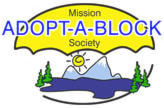You can feel a buzz of energy in the room as two classes of students eagerly buddy up to prepare for the lesson ahead.
One sixth grader and one first grader team up armed with a bag, picker, and clipboard. With permission, they charge across the school yard in all directions, competing to see which team can collect the most tallies on their chart.
It’s not your typical learning environment but perfect for the Mission Adopt-a-Block’s School Litter Challenge, an outdoor and hands-on program designed to encourage students to take action in their community.
With what began as a pilot program involving a handful of classrooms, in litter abatement efforts, the School Litter Challenge has now grown into a school district-wide program engaging the participation of over 5,700 students each year.
Now mandatory in all Mission schools, each create unique methods for tackling the issue of litter on the school yards and surrounding community space, but the base requirement is the same – adopt the schoolyard and work together to reduce the litter found there.
“The program has been hugely successful through using education and engagement to reduce and prevent the litter issue in the schools,” said Mission Adopt-a-Block’s society coordinator, Sophie Thomas. “The students all care a great deal about how their actions harm or help the space around them. The School Litter Challenge promotes creative inquiry, requiring students discuss the problem and apply viable solutions.
“It’s encouraging to see how much the students care and how dedicated they are.”
The challenge provides students with a creative opportunity to apply lessons from a multitude of subjects such as math (counting, graphing, sorting, etc.), science (toxins, stream health, habitat awareness, etc.), and English using language games and active discussion.
Placing students outdoors to learn also supports their physical literacy as students run, balance, and skip while searching for litter.
Rotating the responsibility through the classrooms, students collect schoolyard litter as often as a couple of times a week and sort it into recyclables, compostables, and landfill waste. This approach supports recycling and composting programs that may be in place at the school already.
The sorting of recyclables uses the Recycle BC guidelines, a provincial stewardship program joined by the District of Mission in April of 2017 to help with the Mission district’s waste diversion goals.
An important first step for every school is that Mission Adopt-a-Block staff members meet first with teachers and then guide a school litter audit to discuss issues about bear and wildlife safety, damage to community infrastructure, how to safely handle litter, and how students can actively prevent litter at school and at home.
With the financial support of the Mission School District, Mission Community Foundation, and the Fish and Wildlife Compensation Program, each school now receives a full kit to support their efforts.
Each kit includes a large wheeled bin, three smaller sorting bins, pickers, clipboards, and a tarp. This makes it easier for all necessary equipment to be brought to other locations as well, such as neighbouring parks and streams.
“Most schools have taken on the adoption of an adjacent area, often a park or ravine space. One school has even adopted a river and takes the students by bus once yearly to clear litter,” said Thomas.
“These adoptions tend to be the responsibility of a leadership class or environmental club, but other adoptions are by individual classrooms championing environmental awareness in the school.”
